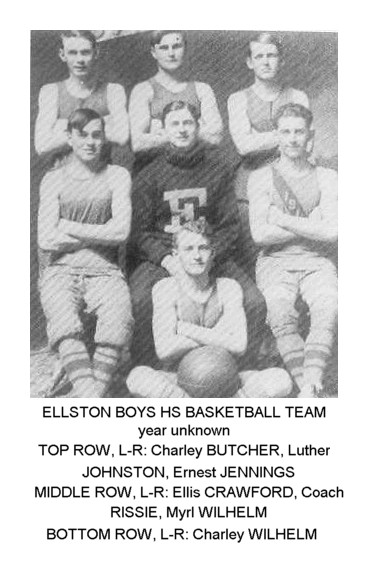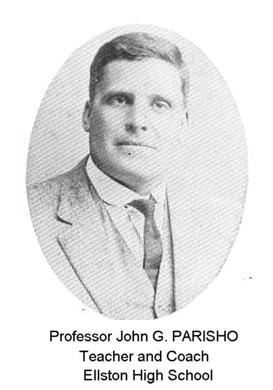|
Mount Ayr Record-News
Mount Ayr, Ringgold County, Iowa
ELLSTON SCHOOL
Early History of Basketball at Ellston
By Merle WILHELM

In the early winter of 1911, Zell ROBINSON, editor of the Ellston Eagle, got permission to use the old opera house
for a practice court. Every boy was given a chance to learn the game and, of course, to share the expenses. Bert BROWN,
unable to play on account of an artificial limb, did the officiating and ROBINSON coached and played. It was hit or
miss (mostly miss) style of game that we played. After a couple of months practice ROBINSON picked a team to go to Mount
Ayr and play their town team. As expected, we took a beating from those older and more experienced players. That defeat
didn't dampen our spirits and at the start of school in 1912 we took the game into high school. Prof. DALZALL was not
a coach but helped what he could. We leveled off a court on the schoolgrounds. With only fifteen boys to pick two teams
from we started the ball rolling. Don't expect me to name all of the players correctly. However it seems to me that the
first team and its substitutes were Roy KENT, Clark and Floyd JENNINGS, Albert FOUSER, Prof. DALZALL'S brother-in-law
whose name I have forgotten, Ralph MASON, Brother Charlie and myself. We lost all six games we played that season. In
1913 the team was coached by Prof. PRATHER and Mr. ATHA and we won eight out of 16. That was the year we built the Old
Gym with the work being done by the boys and their friends and merchants donating the money for the material. About all this
building did was to put the game inside. It was heated by two stoves and lighted with gas lights. It usually froze inside
about as soon as it did outside. We had a dirt floor for awhile but were soon able to get a wooden one.
 In 1914 we had Prof. RISSE as a coach and won 10 out of 13 games.
In 1914 we had Prof. RISSE as a coach and won 10 out of 13 games. During those early years players paid for their own
uniforms except shoes and most of these were handed down from team to team. We traveled via train to such places as
Weldon, Garden Grove, Clearfield and College Springs because autos were not practical through the winter months. Our
big trip in 1913-1914 was to College Springs where Prof. DALZELL taught. We had our own string band and quartet. The
wise cracking of Charley and Luther JOHNSTON furnished entertainment for the train crew, passengers and ourselves. So,
win or lose, we had fun. It was the custom in those days for the school children to take the visiting team home for
meals and lodging, if they had to stay over night. I remember a trip to Weldon when I was taken out to a farm. The next
morning we had to pick apples until noon before we could go back to Weldon to play the afternoon game.
Mount Ayr Record-News
Mount Ayr, Ringgold County, Iowa
Hardships bred rugged players
By George ANDERSON in 1958

Playing in the Old Tin Gym made us rugged. One time Lenox forced us to suit up in the warm hotel room and walk five or
six blocks in below zero weather to the old opera house to play ball. In spite of these hardships we played good ball and
won the game 15 to 11. When we got back to Ellston the next day on the two o'clock train we headed straight for the schoolhouse.
I wrote the score on the board and everyone took three minutes out to cheer. Afterwards everyone settled down to work -
including us. This is quite different from the welcom that greets the conquering heroes of today. I wonder how many
players would do this to play a game today? When we played in the Ringgold county tournament for the first time, we drove to
Mount Ayr with a team and wagon on a bitterly cold day. The ground was frozen and rough. Prof. COMER walked most of the
way to keep warm. He wore out a new pair of dress overshoes on the trip. He was supposed to be coach. However, not knowing
the game, he turned the job over to the boys. Harvey WILHELM acted as coach and I was captain. After the game Supt. COMER
was jubilant and bought us boys a large box of chocolate candy.
Mount Ayr Record-News
Mount Ayr, Ringgold County, Iowa
Thursday, July 19, 1976
The Fire in the Ellston Gymnasium
Winter of 1917-1918
By the late John G. PARISHO

 Before describing the fire and the game with Indianola High School which it interrupted, it is best to describe the
gymnasium and its lighting and heating systems.
Before describing the fire and the game with Indianola High School which it interrupted, it is best to describe the
gymnasium and its lighting and heating systems. The building was the product of local energy and contributions and it
consisted of a wooden frame work of two by sixes and two by fours. The roof and sides were made of tin. The dimensions were
about 50 by 60 feet. We attempted rather unsuccessfully to heat it with four stoves, one in each corner. In order to
understand the situation, one must realize that electricity had not yet been installed in Ellston. The common lighting
system used in the stores, the Odd Fellows Hall, and in our Gymnasium was a gas lighting system known as the F.P., Fool Proff,
which it wasn't. It depended on pressure which one pumped up. I would be untrue to the people of Ellston who contributed
to this building and so loyally supported the team if I failed to tell how Mart NEEDHAM, a good carpenter, helped seal the
sides and erect new bleachers just prior to the Indianola game. Loyal fans, who some years prior to my arrival in
Ellston had erected this edifice, never failed to miss a game or cheering on the team by their presence. The team itself
wond 17 straight games. They won South West Iowa and their first game in the state tournament over Goldfield, 30-22,
before losing to the state champs, mt. Pleasant, 28-15. I must mention the boys who made up this team. They were
as follows: Harley WILHELM, John GARLAND, LeGrande MILLER, Guy JACKSON, George ANDERSON, Garnet (Cap) KRON, Ralph
GILLETTE, McKinley ROGERS, Byron HOFF, and Nile MILLER. In the game we were playing, we were leading Indianola by a
comfortable margin when time was taken out for some reason. I foolishly asked someone to pump up the light and instantly
there was an explosion. The overflow crowd, I know, vacated the building in 15 seconds or less except for a bewildered
couple sitting on the north bleachers, who escaped through the window into BUTCHER'S Chicken Yard. While the bucket
brigade was forming, some eager but misguided fan siezed a club and broke out all the windows on the south side. The fire
was at last extinguished but the water-covered floor was unfit for play. At least one-half barrel of salt was put on the floor.
Gas lanterns were borrowed, play was resumed and the final score was Ellston 40, Indianola 14. Most of the fans of early
evening had gone, and the people who saw the finish were the older people who came to see the fire and helped put it out.
The Indianola fans had their revenge when we returned the game. Upon our arrival at teh Warren County metropolis, we were
greeted with the shout, "Has your barn burned down yet?" But we beat them again 28 to 20. I forgot to mention the name of the
Beaconsfield auctioneer who had bet against us and exclaimed when the fire broke out, "Let it burn." About two years later,
I think, electricity came to Ellston. I was superintendent of Ellston from 1916 to 1918. During the year 1918-1919 I served
as superintendent of Humeston, then returned as superintendent at Ellston for three years, 1919-1922. In closing let me make
another statement: "In all these years the school house was used as a dressing room for the home team and visiting team,
and nothing was ever stolen, though the building was unlocked. A fine tribute to the character of the fans."
Transcriptions by Sharon R. Becker, May of 2010


| 

